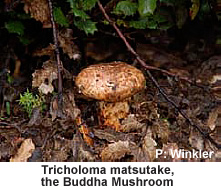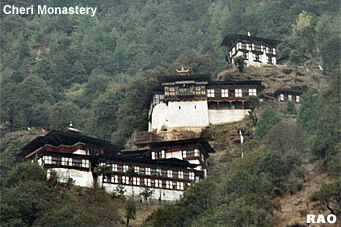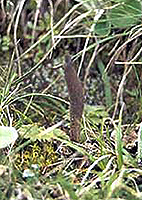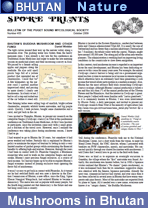| Cordyceps sinensis - Yartsa Goenbub in Bhutan |
| Highly
valued medicinal plant |
 |
Bhutan's Nature Yartsa Goenbub |
|
 |
Bhutan Information |
|
|
 |
| Bhutan's Buddha Mushroom and other Fungi |
 |
| Mushroom expert: Daniel Winkler in Bhutan |
 |
 |
The tight curves wound their way up the narrow valley along a mountain river. The gushing water was brown from the heavy monsoon rains. I was already a day late for the conference on Traditional Asian Medicines and eager to make the late morning session on medicinal plants and their increasing scarcity in Asia. We passed by a farmer selling apples and peppers along the roadside. He also sold small plastic bags full of a yellow product that reminded me of chanterelles. Could that be?
|
A few kilometers up the narrow road I spotted another improvised stand, and passing by more slowly I clearly saw mushrooms. In a hurry or not, I had to call a stop and rushed out of the car before it stood still.
 |
| Two farming ladies were selling bags of smallish, bright-yellow chanterelles, aromatic whitish brown matsutake, and big purple corals. Quickly, I took pictures, bought some chanterelles and a coral, and got back in the car. I was invited to Thimphu, Bhutan, to present my research on the caterpillar fungus (Cordyceps sinensis) in Tibet at the quadrennial conference on Traditional Asian Medicines. At first I was hesitant to participate, since the invitation came only with a small grant, just a fraction of the travel costs. |
|
However, once I realized the conference was taking place during mushroom season, I knew I had to go. I had wanted to go to Bhutan for 20 years, but somehow it had never worked out before. Partially this is explained by Bhutan's policy to minimize the impact of tourism by letting in only a very limited number of guided groups while maximizing the financial benefits by offering high-end tourism.
However, through the years I had been in contact with Dr. Phuntsho Namgyel, a Bhutanese researcher who used to work on the caterpillar fungus and mat-sutake, Bhutan's most precious fungal resources, as a source of rural income. So I had my hopes up to be able to explore Bhutan's fungal economy instead of joining exclusive tours ignoring the forest full of mushrooms. It wasn't so easy to get back in contact with Phuntsho.
As it turned out he had switched fields and was now a director in the Election Commission of Bhutan, a new office, since the King, Jigme Khesar Namgyel Wangchuck, had ordered Bhutan to become a democracy. This move was not so popular with many people, but the fourth king pointed out that democracy is the future and one bad king could ruin a country.
Bhutan is located in the Eastern Himalayas, sandwiched between India and Chinese-administrated Tibet AR. It is nearly the size of Switzerland and has fewer than a million inhabitants (Switzerland has 8.1 million); the whole valley with the capital, Thimphu, might have around 100,000 now. The strong pull of the urban area worries planners.
The administration is working hard on improving living conditions in the countryside to slow down emigration. In this context, rural mushroom income is regarded as an important factor for rural development, and Bhutan has been dedicating resources to this cause for many years now.
For example, the annual Cordyceps sinensis harvest is being sold via a government organized auction system to maximize local income in remote regions, which otherwise have an extremely hard time generating a cash income that would allow participation in a modern economy.
Also, Bhutan has the most advance field trials researching Cordyceps sinensis ecology, although Bhutan's annual production is below a ton and thus less than 1% of the annual production of the Tibetan Plateau and the Himalayas (see also: Drukair flight over the Himalayas and Himalayas in Nepal). And the interest in Cordyceps is great. Most people I talked with were familiar with "yartsa guenboob," as it is commonly known in Bhutan.
I was even interviewed by Bhutan Today, a daily newspaper, and invited to present my Cordyceps research from Tibet at the ministry of agriculture [see MOA link for a web version).
Still during the conference, Phuntsho took me to the National Mushroom Center, just a short walk from the venue, to meet his friend Dawa Penjor, the NMC director, whom I presented with booklets on PNW chanterelles, morels, and matsutake. We connected quickly through our shared fascination with mushrooms. I told Dawa that I would love to go out in the field with them.
 |
| Dawa was so kind as to organize an overnight excursion to Ganekha, the village where the "first" matsutake was found. Actually, this mushroom was known before, but in 1988 a Japanese visitor realized that Bhutan's "Po shamu" (penis mushroom), as it was nicknamed back then for its sometimes suggestive shape, was identical with the famous Japanese matsutake. Already the next year, commercial harvest had started, and ever since then it has been collected in several areas in Bhutan that have warmtemperate oak-pine forests. Most of the matsutake are exported fresh by plane to Japan. All it needed was a new name; everyone now knows it as "sangay shamu," the Buddha Mushroom. |
|
In Ganekha we met the village headmen and the chairman of the local mushroom cooperative, who coordinates the matsutake harvest. We talked about matsutake in Bhutan, Tibet, and the Pacific Northwest. Our visit was timed so that we could attend the matsutake market the next afternoon. Several buyers come to the village three days a week, and all the local collectors bring their matsutake, which are sorted into two categories:
Class A are specimens whose caps have not fully opened and whose partial veil is still more or less intact. Collectors can sell this class for US $5 per pound.
Class B are open-capped mushrooms and fetch $2. Most mushrooms sold are class A. Collectors make $650–850 per season, which constitutes over 40% of their income.
A decade ago matsutake generated over 80%, but the money from the trade has been used to invest in agriculture to buy cows, diversify crops, and introduce power tillers. Thus, the fungal income enabled farmers to increase overall income. This strategy was also strongly supported by Bhutan's king, who, when visiting Ganekha, pointed out that complete dependence on matsutake is not a smart strategy for sound rural development and suggested diversification.
Dawa and Phuntsho had arranged with Aum Kuchum, the lady who had found the first matsutake, to stay the night in her house and join in on an early morning matsutake hunt. She lived in Zamto village, about half an hour's drive on a very rough road up the valley. On the way we encountered a collectors' camp on a small meadow surrounded by dense oak forests. Thirty-five men from a lower village for whom the walk up into the woods was too far for a daily hunt had camped out in group tents. Their daily work was done, and they were playing Khuru, throwing heavy metal darts over a distance of 20 yards. We were invited to join in, and it took quite awhile until I managed to figure out how to give the weighty dart the right spin to fly straight.
We continued on, only to find the road blocked by a landslide. In May, totally untypical, a typhoon had struck Bhutan and caused much destruction. So we had to hike the last bit. The narrow valley opened up between forested slopes. The southern slope was dotted with tall, beautiful wooden farmhouses with ornate windows surrounded by already harvested fields.
Once in the house, which we entered by way of a small bridge over a dry moat, we were served milk, tea, and cookies. This was soon followed by a sumptuous dinner.
First we received a big bowl of "red rice," a rice with a natural pinkish grain. I was shown how to use the cooked rice to clean my hands by first rubbing it and then kneading it in my hands. The color change convinced me that my hands should be clean enough to eat my food with. On top of my rice I received a ladle each of "ema datsi" and "shamu datsi." Datsi is a cheese sauce, somewhat close to our idea of a cream sauce, and a Bhutanese favorite. Ema are green chilies. In Bhutan hot peppers are a vegetable, not a spice. Incredible amounts of hot green and red chilies are eaten every day.
Not surprisingly, the shamu datsi - mushrooms in cheese sauce - were also enriched with lots of chilies. The mushroom served was the Himalayan Gypsy (Rozites emodensis), which looks just like its close relative the Gypsy (Rozites caperata) but can be distinguished by the pinkish-purple hue of its gills and the wrinkled cap. It was difficult to discern its taste beyond pleasantly fungal owing to the overwhelming presence of the green peppers. Rounds of arak, a clear alcohol derived from grain, often rice, were also served, but arak turned out to be the wrong kind of drink to fight the spiciness of the food.
We went to bed early, since we were scheduled to rise at 5 a.m. to hunt for matsutake.
At dawn, following Dema, the daughter of Aum Kuchum, we quickly traversed some pastures covered with aromatic wild hemp on the way uphill to the matsutake forest. The altitude of nearly 10,000 ft slowed me down. In the morning light, the forest of stout evergreen oaks (Quercus semecarpifolia) and Bhutan pines (Pinus wallichiana) decorated with long strands of Usnea lichen interspersed with tall Rhododendrons and Pieris shrubs seemed like it was out of a fairy tale. The silver gray Usnea longissima is also known in Bhutan as Dakini hair. Dakinis are female beings which usually reside in a different sphere but once in a while manifest in the human dimension to help humans along the path to wisdom.
It did not take any divine intervention to find the first mushrooms. Bright yellow chanterelles and a variety of Russulas dotted the ground. Matsutake were much more elusive, the daily collection by locals having cleaned out the forest successfully. Or maybe they were all hidden? A small Class A budding matsutake was found, but since it was still below the minimum size of 3 inches required by collection regulations we hid it under some moss so it could grow some more.
Soon I lost sight of Dema, Dawa, and two of his people, since taking mushroom photos and identifying species to a new member of the Mushroom Center slowed me down. We found many familiar mushrooms such as chanterelles (Cantharellus cibarius), russulas (R. emetica, R. cyanoxantha, and R. delica), amanitas (A. citrina and A. franchetii), milk caps (Lactarius scrobiculatus and L. rufus), and a whole range of Tricholoma such as T. sejunctum, T. sulphureum, and T. focale.
Also we came across a big purple Ramaria called "Bjichu kangru", the bird foot; nobody knows the exact scientific name, but everybody eats it. Also abundant was the Himalayan Gypsy (Rozites emodensis). We picked the young ones, but left behind many more old ones, which lose much of their pink-purple complexion. But, of course, there were plenty of mushrooms I had never seen in my life or just couldn't place.
Returning to the farmhouse, we started an ID session with European and Japanese books, as there are no Himalayan mushroom Tricholoma matsutake, the Buddha Mushroom books. Dawa is very troubled by using European names, but has no real alternatives owing to the lack of comprehensive taxonomic research in the region. I told him many mushrooms in North America were also named for European species and received their own names a century or decades later. Dawa was aware of the case of our Pacific chanterelle, C. formosus, which was known for a long time as C. cibarius, although it is very distinctive.
 |
| Talking about chanterelles, while collecting with Sabrintara and Dorji, both members of the NMC, below Cheri Gompa up the valley from Thimphu, we found "regular" chanterelles (Cantharellus cibarius), white chanterelles (Cantharellus sp.), and a blue-gray chanterelle (Craterellus cornucopioides); the last, known as the Horn of Plenty, is an excellent edible but is not often eaten in Bhutan because of its dark color. (Interestingly, close by in Tango I found the winter chanterelle Craterellus tubaeformis, but was told by a fungophile monk that this mushroom was not edible.) |
|
Also on this very moist shady slope under deciduous oaks, I found my first Amanita rubrovolvata, a beautiful, tiny, light-red, spotted fly agaric with a red volva. Another tiny, but stunning, mushroom was a viscous Suillus with a dimpled dark brown cap. Big old oaks served as habitat for Ganoderma and hand-sized Oudemansiella, which grew below leaning trunks, probably preferring the rain protection for fruiting.
With us looking for mushrooms in the woods were a bunch of young Nepali women (Bhutan has a big Nepali population), who were picking any good-sized mushrooms, often asking us if they could eat them. We told them we didn't know what they were picking, and it is not smart to eat any mushroom you cannot recognize for sure. They did not care for that bit of information and went their way with a wild assortment, at least with no deadly mushrooms as far as we knew. Also, several people told me that there are many people who are convinced that any toxicity in a mushroom can be neutralized by cooking them with the seed from a native Prickly ash, "tingke" (Zanthoxylum sp.), known in China as Sichuan pepper.
The consumption of mushrooms not really known to the collectors is a big problem in Bhutan. Every year many people get sick or even die form eating poisonous mushrooms. One of the Mushroom Center's main objectives is to educate the public. Dawa and the NMC have published two posters of the main edible and poisonous mushrooms. They have also produced table calendars and brochures about poisonous mushrooms and mushroom poisonings - with symptomatic diagnoses - which have been distributed widely in Bhutan.
In addition, the NMC is working on a compilation of Bhutan's mycota, but there is no end in sight. (In Europe some mycologist suggest calling the fungal flora "funga," which seems a good choice, staying with Latin in the context of flora, fauna, and funga, not to mention the catchy alliteration.)
Dawa emphasized that NMC would love to be able to send some of its staff abroad for training to improve their taxonomic skills and pointed out that taxonomic experts interested in coming to work in Bhutan - which not only has a forestation rate of over 70% but also boasts an incredible biodiversity, from tropic Himalayan foothills to high alpine areas peaking out at 24,000 ft - may have the opportunity to help NMC in mushroom taxonomy. If there is any mycology department interested in cooperating with Bhutan and able to offer an opportunity for training, I would be glad to help in making a connection.
Another main task of NMC is disseminating the know-how of mushroom cultivation in the country. When I was visiting, NMC was growing Shiitake, Pleurotus, and Ganoderma.
 |
| But let's get back into the soaked oak forest on a 60° slope. The extreme steepness slowed us down and the mossy "ground" in the form of the slope was right in our faces. As I was photographing a big white Ramaria (the main challenge was not sliding down), I noticed a minute, filigreed fruiting body with a yellow base and the rest all covered in white spores, like a small tree covered in powder snow. Eureka! I had found a Cordyceps. We looked all around and found four more minute similar fungi. Well, it turned out we had found three different species, all technically not Cordyceps, but anamorphs of Cordyceps, one of them most probably Isaria tenuipes. This I was told by Dr. Nigel Hywel-Jones, a Welsh mycologist who started out as an entomologist but slowly was caught in the fungal web and has been researching Cordyceps fungi in SE Asia for two decades. His recent research focus is in Bhutan. |
|
Although it is absolutely fascinating discussing Cordyceps and other entomophagous fungi with Nigel, he himself is not much of a mycophagist. However, that wasn't much of an issue in a country where the only Italian restaurant serves you an excellent pizza con funghi cooked with fresh Sisi shamu, the oak mushroom, which we know as chanterelles.
PS: I will be posting photos from Bhutan on my webpages: www. MushRoaming.com. (links and download)

|
| This
article was contributed by Daniel Winkler, October 2009 |
top
| Mushrooms in Bhutan |
 |
top
| Information on Bhutan |
 |
| Links |
 |
 |
 |
External
links |
| Articles written by Daniel Winkler |
|
 |
|









